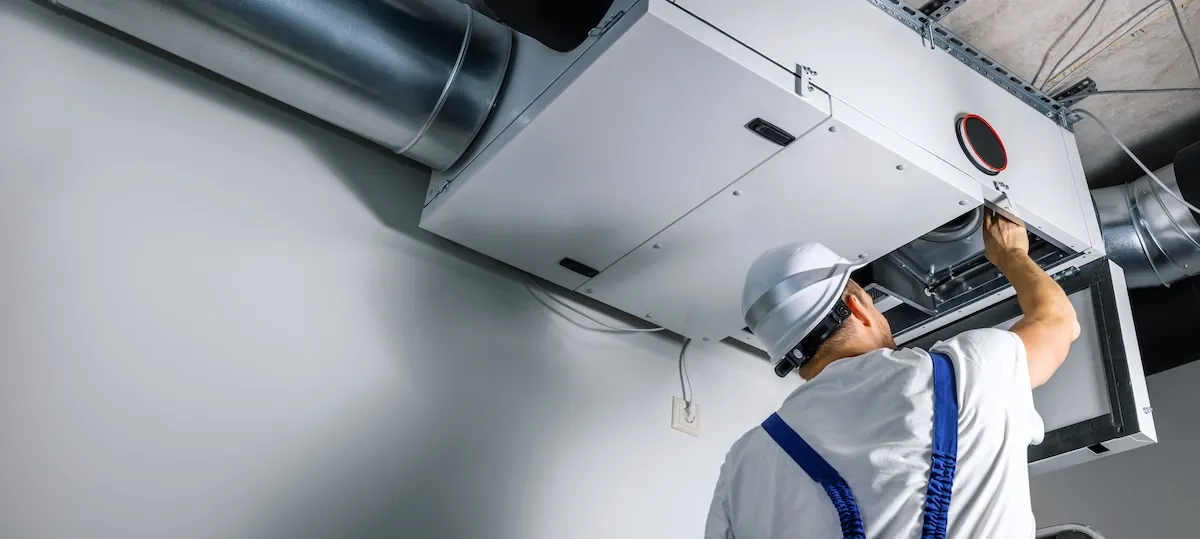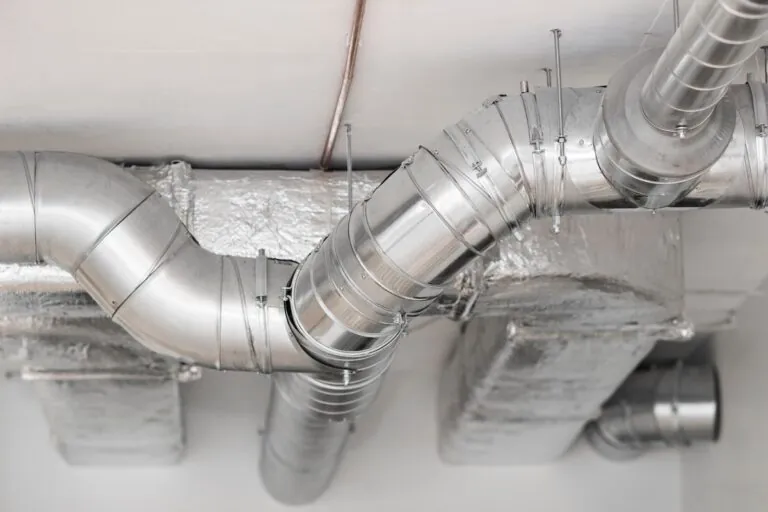If you’ve heard the term “air exchanger” but aren’t exactly sure what it does, you’re not alone. An air exchanger is a ventilation system that improves your home’s air quality by bringing in fresh outdoor air and pushing stale indoor air out. It’s especially useful in today’s airtight homes where natural airflow is limited.
In this guide, you’ll learn:
- What an air exchanger is and how it functions in a home.
- The benefits it offers for comfort, health, and energy efficiency.
- When you might want to consider adding one to your HVAC system.
💨 What Does an Air Exchanger Do?
An air exchanger is designed to manage ventilation in a controlled, energy-efficient way. It ensures that your home has a steady supply of clean air without letting heat or cooling energy go to waste.
- Primary purpose: An air exchanger continuously replaces stale indoor air with filtered outdoor air, helping control humidity and reduce airborne pollutants.
- Energy efficiency: Unlike opening windows, air exchangers are engineered to retain heat or coolness during the air swap, maintaining comfort without overworking your HVAC system.
- All-season solution: Whether it’s hot and humid or cold and dry outside, an air exchanger balances the indoor environment to support better air quality year-round.
They’re especially effective in homes with tightly sealed windows, modern insulation, and minimal natural airflow.
🤔 How Does an Air Exchanger Work?
While the exact design may vary by model, all air exchangers follow a similar process that keeps your indoor air cleaner and healthier.

Air Intake and Exhaust
The system uses fans to draw in fresh air from outdoors while simultaneously expelling stale air from inside your home. These two streams never directly mix, so pollutants from indoors are removed without contaminating the incoming air. The flow is continuous and adjustable, depending on your system settings.
Heat or Energy Recovery
Most air exchangers are classified as either HRVs (heat recovery ventilators) or ERVs (energy recovery ventilators). HRVs transfer heat from outgoing air to incoming air during winter to maintain warmth. ERVs go a step further by also managing humidity—ideal for homes in climates with high moisture levels.
Built-In Filtration
Before the outdoor air enters your home, it’s filtered to remove dust, pollen, and pollutants. This makes air exchangers an excellent solution for households with allergies, pets, or other air quality concerns.
✅ Benefits of Installing an Air Exchanger
The advantages of an air exchanger go beyond just fresh air—they support a healthier and more comfortable living environment.
- Improved indoor air quality: Constant airflow removes dust, pet dander, mold spores, and household odors that can build up in enclosed spaces.
- Balanced humidity: In both summer and winter, air exchangers help stabilize indoor humidity levels to reduce the risk of mold or overly dry air.
- Energy savings: By recycling thermal energy from outgoing air, the system reduces how hard your HVAC unit has to work.
- Healthier breathing: Fresh, filtered air reduces allergens and airborne irritants that can worsen asthma or allergy symptoms.
- Protection for your home: Lower indoor humidity means less condensation on windows and reduced strain on walls, insulation, and wooden structures.
⚠️ 5 Signs You Could Benefit From an Air Exchanger
If you’re wondering whether your home needs an air exchanger, here are a few signs it might be time to consider one:
- Stale or musty air: If your home smells stuffy or the air feels “thick,” ventilation may be insufficient.
- High humidity or condensation: Moisture on windows or in bathrooms is a sign your air isn’t circulating well.
- Allergies or respiratory irritation: Poor air quality can lead to more sneezing, coughing, or dry throats indoors.
- New construction or recent upgrades: Airtight windows and insulation may limit natural airflow, creating an imbalance.
- Strong odors that linger: Cooking smells, pet odors, or smoke that stick around longer than they should are another red flag.

🛠️ Air Exchanger Maintenance Tips
Like any part of your HVAC system, an air exchanger performs best with regular upkeep. Routine maintenance helps it stay efficient, clean, and reliable throughout the year.
- Filter cleaning or replacement: Most air exchangers have one or more filters that trap dust and debris. These should be cleaned every few months and replaced at least once or twice a year, depending on your air quality and system usage. Neglecting filters can reduce airflow, increase energy use, and strain internal components.
- Check and clean vents: Supply and exhaust vents—both indoors and outdoors—can become blocked by dust, lint, or even leaves and debris. Inspect vents every season to ensure unobstructed airflow and efficient performance. Clear vents help the system breathe properly and prevent imbalances.
- Inspect core and fans annually: The energy recovery core and internal fans should be inspected and cleaned by a professional technician once a year. Dust buildup can affect energy transfer and cause moving parts to wear down faster. Professional cleaning ensures your system runs quietly and effectively long term.
👉 Do Air Exchangers Work with All HVAC Systems?
Yes—most air exchangers are compatible with existing HVAC systems. In fact, they’re often installed as add-ons to support central heating and cooling systems.
- Integration with ductwork: In a typical installation, the air exchanger connects to your home’s existing ductwork. This allows it to deliver fresh air to living spaces and draw out stale air from bathrooms, kitchens, and laundry rooms. The system runs independently but complements your HVAC setup for year-round comfort.
- Energy efficiency boost: By transferring heat or moisture between incoming and outgoing air, air exchangers reduce the workload on your HVAC system. This can lower your energy bills, improve airflow balance, and extend the life of your heating and cooling equipment.
- Flexible options: Air exchangers come in various sizes and models to fit homes large and small. Whether you want basic ventilation or full energy recovery, there’s a system that can be tailored to your needs and home layout.

⭐️ Breathe Easier with Genz-Ryan
Understanding what an air exchanger does is the first step toward improving your home’s air quality. If you’ve noticed lingering odors, allergy flare-ups, or heavy humidity, it may be time to consider upgrading your ventilation system.
Contact Genz-Ryan today! We’ll assess your needs and recommend the right air exchanger to help your home feel fresher, cleaner, and healthier, season after season.








